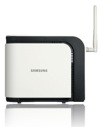Tech Toy of the Month – Sprint AIRAVE

Currently only available on the Sprint network, the $100 AIRAVE is basically a mini cell phone tower that you can place in your home or office. Unlike other signal boosting technologies which simply retransmit the signal from a nearby cell tower, the AIRAVE uses your broadband Internet service to connect to Sprint’s network. By doing so, users who are in extremely poor coverage areas can still receive strong signals. This is because the signal boosting is not dependent on nearby towers since the AIRAVE is relaying calls directly to Sprint’s network via the user’s Internet connection.
Another potential advantage of the AIRAVE is that Sprint does not charge airtime minutes while a user is connected to the device. Instead, Sprint charges a flat rate of $5 – $10 per month depending on the user’s current plan for unlimited use of the AIRAVE. If a user uses a lot of cell minutes while located in a particular building, this can be advantageous. On the flip side, if a user is frustrated by the lack of coverage in a building, paying another $5 – $10 month to improve their coverage may not seem like a good deal. Some reports on the Internet state that Sprint may be offering the AIRAVE free of charge to customers with poor coverage, but of course, take these reports with a large grain of salt.
Another potential issue with the AIRAVE is with the requirement for a broadband Internet connection. Many areas that lack good cell coverage also lack broadband Internet! Many users in remote locations do have satellite Internet service, but it is not likely that the AIRAVE will work well with satellite Internet services. While satellite services can provide good bandwidth, they have high latency which will probably not work well with a cell phone call. So the AIRAVE probably won’t be a good solution for users in remote areas.
If the AIRAVE does well, expect other wireless providers to follow up with devices of their own. These devices could become extremely popular, as it allows wireless providers to let users solve their own coverage issues fairly easily. In theory, this can save the wireless companies money since they may not need to deploy as many cell towers.
Contact Marcel for any questions you may have regarding the latest technology gadgets!
